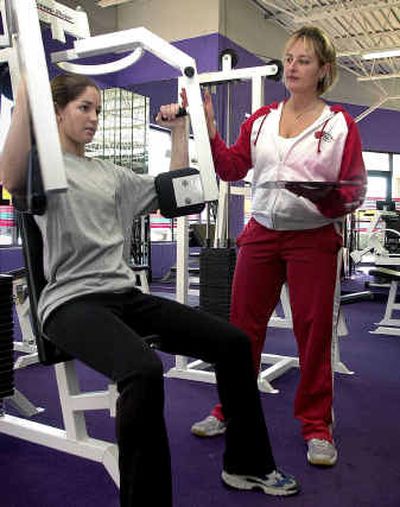Health clubs see market in children, teens

NEW YORK – Lori Robinson was excited when she learned that her health club had another gym catering to children – she thought it was an excellent idea for her two teenage daughters, who were slightly overweight.
“They are not overly involved in sports at school so this is a good way for them to get exercise,” said Robinson, of Fairview, N.C.
Her daughter Brittany, 15, has become a fan of Cardio Kids, the gym where she takes kick boxing and step aerobic classes. Her sister Kayla has been sidelined by an operation, but hopes to get back to the gym, too.
“I had a weird feeling (at first) because I’d never done anything like this before,” said Brittany, who has lost about 15 to 20 pounds since joining the gym. “You have fun when you lose weight.”
The childhood obesity epidemic combined with cuts to schools’ physical education budgets has inspired commercial gyms and health clubs to launch programs aimed at those under 18. The idea appeals to kids, and also to parents looking to help their children develop a healthy lifestyle or improve their chances of winning an athletic scholarship or a spot on a sports team.
The programs are a growing source of revenue for the health club business. The number of gym members under the age of 18 rose 29 percent to 4.5 million in the five years ended in 2003, according to the International Health, Racquet & Sportsclub Association.
Kim Hreha started Cardio Kids in September of 2003 because clients at her other gym, Ladies Workout Express, said their children weren’t getting enough exercise at school, and the mothers also worried about the kids playing outside after school without supervision.
“We want to give kids a safe alternative (for exercise),” said Hreha, whose gyms are located in Asheville, N.C. “It is a relaxed atmosphere and kids don’t even know they are working out.”
Health club executives say marketing to the young makes sense because hooking people on fitness early can create lifelong clients.
“We are in the membership business and we’ve been going about this backwards,” said Lori Lowell, National Group Fitness Director for Gold’s Gym International Inc. and owner of two Gold’s franchises. “We should cater to young people.”
Lowell said all of Gold’s 40 company-owned clubs and some of its 500 franchised gyms in the United States offer activities for kids. She is trying to develop children’s programs that could be rolled out across the country.
But creating a program with nationwide appeal might be a challenge.
For example, the Gold’s Gym in Bee Caves, Texas, started a tumbling and gymnastic program for kids 3 to 7 in February that was successful, according to Tricia DeTurris, the company’s group fitness director for the Austin, Texas, area. However, tumbling classes at three other locations haven’t been as popular.
DeTurris said Bee Caves’ location, in an affluent community with a fair number of stay-at-home moms who can drive their kids to classes, may account for the difference. Scheduling the classes later, after parents get home, is one option, but DeTurris said programs can’t be held too late in the evening because children won’t be able to attend and the classes could cut into time slots set aside for adults.
Timing kids’ classes isn’t the only obstacle. Instructors must have the right mix of patience and energy while classes must be tailored to children’s needs. Children’s yoga sessions tend to be more active and less static than those for adults, said Cheryl Jones, vice president for program and services for Town Sports International, which owns 140 clubs in the northeast and Washington D.C.
“The key is to keep kids engaged,” said Jones. “Typically your top adult instructor is not your top kids’ instructor.”
Jones said 15 of her company’s clubs offer activities for kids including swimming programs, soccer and various classes. The company plans to test a class for 7 to 11 year olds designed to improve their strength, agility and flexibility through activities such as sprinting, tossing medicine balls and climbing ladders. It was created to enhance children’s overall sports performance.
Orthopedic surgeon Dr. Kevin Plancher said parents should take precautions to make sure the gym activity is age appropriate and not too strenuous.
“You don’t want to turn them off exercise,” said Plancher, who practices in New York and Stamford, Conn.
He cautioned parents to be aware that illegal steroids are sometimes passed out at gyms, and that children should be warned about the possibility.
Catering to families can be a lucrative endeavor. Life Time Fitness Inc. was formed 11 years ago with the idea of being a family friendly environment and has activities available for kids including rock climbing and swimming. The company went public over the summer and stock price has risen to $25.69 from $18.50 on the New York Stock Exchange as revenues and earnings have jumped.
Britt Booher said her family joined Life Time Fitness because one local gym was a “meat market” and the other didn’t have programs for children under 15.
“I didn’t want to figure out where my kids were going to go when I was working out,” said Booher, of Gilbert, Ariz. Now while Booher runs on the treadmill, her older boys play basketball and her young daughter is in day care at the gym.
“Everyone has their own thing at the gym,” Booher said. “We all have a spot.”